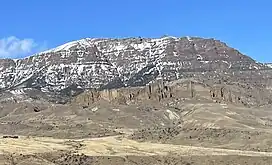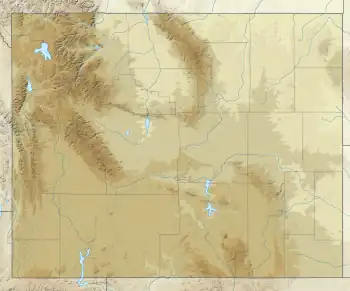| Jim Mountain | |
|---|---|
 South aspect | |
| Highest point | |
| Elevation | 10,430 ft (3,179 m)[1] |
| Prominence | 670 ft (204 m)[1] |
| Parent peak | Peak 12132[2] |
| Isolation | 5.28 mi (8.50 km)[2] |
| Coordinates | 44°31′45″N 109°28′28″W / 44.5292286°N 109.4745119°W[3] |
| Naming | |
| Etymology | Jim Baker |
| Geography | |
 Jim Mountain Location in Wyoming  Jim Mountain Jim Mountain (the United States) | |
| Country | United States |
| State | Wyoming |
| County | Park |
| Protected area | North Absaroka Wilderness |
| Parent range | Absaroka Range Rocky Mountains |
| Topo map | USGS Jim Mountain |
| Geology | |
| Type of rock | volcanic breccia |
| Climbing | |
| Easiest route | class 2 |
Jim Mountain is a 10,430-foot-elevation (3,179-meter) summit in Park County, Wyoming, United States.
Description
The mountain is situated 20 miles (32.2 km) west of the town of Cody and can be seen from Highway 20 approximately midway between Cody and Yellowstone National Park. It is set in the Absaroka Range along the boundary of North Absaroka Wilderness on land managed by Shoshone National Forest.[2] Precipitation runoff from the mountain drains into tributaries of the Shoshone River. Topographic relief is significant as the south aspect rises 4,830 feet (1,470 meters) above North Fork Shoshone River in four miles (6.4 km) and the east aspect rises 2,000 feet (610 meters) above Jim Creek in one mile (1.6 km).
Etymology
Jim Mountain is named after Jim Baker (1818–1898), frontiersman, trapper, army scout, interpreter, and rancher.[4] The mountain's toponym has been officially adopted by the United States Board on Geographic Names.[3]
Climate
According to the Köppen climate classification system, Jim Mountain is located in a semi-arid climate zone with cold, snowy winters, and cool to warm summers.[5] Winter temperatures can drop below −10 °F with wind chill factors below −30 °F. Due to its altitude, it receives precipitation all year, as snow in winter and as thunderstorms in summer, with a dry period in late spring.
| Climate data for Jim Mountain 44.5345 N, 109.4766 W, Elevation: 10,036 ft (3,059 m) (1991–2020 normals) | |||||||||||||
|---|---|---|---|---|---|---|---|---|---|---|---|---|---|
| Month | Jan | Feb | Mar | Apr | May | Jun | Jul | Aug | Sep | Oct | Nov | Dec | Year |
| Mean daily maximum °F (°C) | 24.3 (−4.3) |
24.5 (−4.2) |
30.5 (−0.8) |
35.7 (2.1) |
44.9 (7.2) |
55.4 (13.0) |
66.3 (19.1) |
65.4 (18.6) |
55.5 (13.1) |
41.8 (5.4) |
29.8 (−1.2) |
23.5 (−4.7) |
41.5 (5.3) |
| Daily mean °F (°C) | 16.0 (−8.9) |
15.3 (−9.3) |
20.5 (−6.4) |
25.3 (−3.7) |
34.3 (1.3) |
43.8 (6.6) |
53.6 (12.0) |
52.8 (11.6) |
43.9 (6.6) |
31.8 (−0.1) |
21.5 (−5.8) |
15.3 (−9.3) |
31.2 (−0.4) |
| Mean daily minimum °F (°C) | 7.7 (−13.5) |
6.2 (−14.3) |
10.5 (−11.9) |
15.0 (−9.4) |
23.8 (−4.6) |
32.3 (0.2) |
40.9 (4.9) |
40.3 (4.6) |
32.3 (0.2) |
21.7 (−5.7) |
13.1 (−10.5) |
7.1 (−13.8) |
20.9 (−6.1) |
| Average precipitation inches (mm) | 1.96 (50) |
2.04 (52) |
2.46 (62) |
3.89 (99) |
3.96 (101) |
2.68 (68) |
1.46 (37) |
1.53 (39) |
2.06 (52) |
2.38 (60) |
2.67 (68) |
1.80 (46) |
28.89 (734) |
| Source: PRISM Climate Group[6] | |||||||||||||
Trout Peak is a high mountain peak about 5 miles north of Jim Mountain.
| Climate data for Trout Peak 44.6012 N, 109.5263 W, Elevation: 11,824 ft (3,604 m) (1991–2020 normals) | |||||||||||||
|---|---|---|---|---|---|---|---|---|---|---|---|---|---|
| Month | Jan | Feb | Mar | Apr | May | Jun | Jul | Aug | Sep | Oct | Nov | Dec | Year |
| Mean daily maximum °F (°C) | 18.8 (−7.3) |
18.0 (−7.8) |
22.9 (−5.1) |
29.0 (−1.7) |
38.1 (3.4) |
48.3 (9.1) |
58.7 (14.8) |
57.9 (14.4) |
48.9 (9.4) |
36.1 (2.3) |
24.0 (−4.4) |
18.0 (−7.8) |
34.9 (1.6) |
| Daily mean °F (°C) | 9.7 (−12.4) |
8.0 (−13.3) |
12.3 (−10.9) |
17.4 (−8.1) |
26.2 (−3.2) |
35.5 (1.9) |
44.8 (7.1) |
44.2 (6.8) |
35.9 (2.2) |
24.5 (−4.2) |
15.0 (−9.4) |
9.2 (−12.7) |
23.6 (−4.7) |
| Mean daily minimum °F (°C) | 0.6 (−17.4) |
−1.9 (−18.8) |
1.7 (−16.8) |
5.8 (−14.6) |
14.3 (−9.8) |
22.8 (−5.1) |
30.9 (−0.6) |
30.4 (−0.9) |
22.9 (−5.1) |
12.9 (−10.6) |
5.9 (−14.5) |
0.4 (−17.6) |
12.2 (−11.0) |
| Average precipitation inches (mm) | 4.30 (109) |
4.86 (123) |
5.03 (128) |
5.12 (130) |
5.60 (142) |
3.76 (96) |
1.80 (46) |
1.77 (45) |
2.67 (68) |
4.03 (102) |
5.13 (130) |
4.01 (102) |
48.08 (1,221) |
| Source: PRISM Climate Group[7] | |||||||||||||
See also
References
- 1 2 "Jim Mountain, Wyoming". Peakbagger.com. Retrieved 2023-09-23.
- 1 2 3 "Jim Mountain - 10,430' WY". listsofjohn.com. Retrieved 2023-09-23.
- 1 2 "Jim Mountain". Geographic Names Information System. United States Geological Survey, United States Department of the Interior. Retrieved 2023-09-23.
- ↑ Barry Swackhamer, The American Mountain Man: A Tribute, hmdb.org, Retrieved 2023-09-23.
- ↑ Peel, M. C.; Finlayson, B. L.; McMahon, T. A. (2007). "Updated world map of the Köppen-Geiger climate classification" (PDF). Hydrology and Earth System Sciences. 11 (5): 1633–1644. doi:10.5194/hess-11-1633-2007.
- ↑ "PRISM Climate Group, Oregon State University". PRISM Climate Group, Oregon State University. Retrieved October 12, 2023.
To find the table data on the PRISM website, start by clicking Coordinates (under Location); copy Latitude and Longitude figures from top of table; click Zoom to location; click Precipitation, Minimum temp, Mean temp, Maximum temp; click 30-year normals, 1991-2020; click 800m; click Retrieve Time Series button.
- ↑ "PRISM Climate Group, Oregon State University". PRISM Climate Group, Oregon State University. Retrieved October 12, 2023.
To find the table data on the PRISM website, start by clicking Coordinates (under Location); copy Latitude and Longitude figures from top of table; click Zoom to location; click Precipitation, Minimum temp, Mean temp, Maximum temp; click 30-year normals, 1991-2020; click 800m; click Retrieve Time Series button.
External links
- National Geodetic Survey data sheet
- Jim Mountain: weather forecast